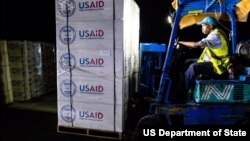On September 1st, Hurricane Dorian slammed into the northern Bahamas. Dorian, which carried sustained winds of 300 [185 mph] kilometers per hour, was the strongest storm in recorded history to hit these islands. While most of The Bahamas was spared, the damage Dorian caused to the islands of Abaco and Grand Bahama was significant.
At the request and under the leadership of Prime Minister Minnis of The Bahamas, the United States mobilized immediately. Once the hurricane passed, U.S. Chargé d’Affaires Stephanie Bowers and Vice Admiral Scott Buschman of the U.S. Coast Guard accompanied Prime Minister Minnis on the first overflights of the affected islands.
After the flight, U.S. Chargé d’Affaires Bowers said, “we are proud to stand hand in hand with our Bahamian friends and partners… We have one collective goal: to assist the victims of one of the strongest hurricanes ever recorded. Now is the time to come together and show what partnership means.”
Agencies throughout the U.S. government responded immediately. The U.S. Coast Guard began search and rescue operations even as the remnants of the storm continued to batter the islands, saving hundreds of lives. The U.S. Agency for International Development, or USAID, pre-positioned personnel and supplies in Miami, Houston, Barbados, Haiti, and Dominica, and brought them to The Bahamas the moment the storm let up.
“As the storm was coming in, we had prepositioned staff and within 24 hours of Dorian striking The Bahamas, we activated and deployed a Disaster Assistance Response Team - an elite team of disaster response experts - to assess damage, to identify humanitarian needs, and to help bring urgently needed assistance to those who were affected, and continue to be affected by this terrible hurricane,” said USAID Administrator Mark Green.
In coordination with local authorities, humanitarian organizations, the U.S. Coast Guard, the U.S. military, the U.S. Embassy in The Bahamas and the 101-member Disaster Assistance Response Team brought its expertise to the effort. After the initial assessments, shipments of crucial aid supplies began to arrive in the hardest-hit areas. This included food, water buckets, hygiene kits, chainsaw kits, and plastic sheeting for emergency shelters.
Thus far, USAID has dedicated $2.8 million in funding for humanitarian assistance to the people in The Bahamas affected by Hurricane Dorian. USAID’s teams covered some 2010 square kilometers of land, air, and sea with search and rescue operations, and assessed bridges and other infrastructure.
USAID Administrator Green said, “Clearly, there is a long and difficult journey ahead. But, to make it very clear, the United States is proud to stand with our neighbors and will continue to stand with our neighbors and friends in The Bahamas as we respond to and help them rebuild from this terrible storm.”














